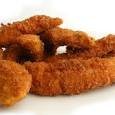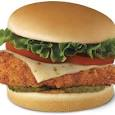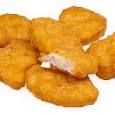| Amount Per 7 fries | |||
| Calories | 220 Kcal (921 kJ) | ||
| Calories from fat | 108 Kcal | ||
| % Daily Value* | |||
| Total Fat | 12g | 18% | |
|---|---|---|---|
| Saturated Fat | 2.5g | 13% | |
| Cholesterol | 35mg | 12% | |
| Sodium | 340mg | 14% | |
| Total Carbs | 14g | 5% | |
| Sugars | 1g | 4% | |
| Dietary Fiber | 1g | 4% | |
| Protein | 14g | 28% | |
| Vitamin C | 1.2mg | 2% | |
| Vitamin A | 0.4mg | 13% | |
| Iron | 1.1mg | 6% | |
| Calcium | 20mg | 2% | |
* Percent Daily Values are based on a 2000 calorie diet. Your daily values may be higher or lower depending on your calorie needs.
Find out how many calories should you eat.
Ingredients And Nutrition Overview
Best
choice Good
choice Poor
choice Avoid
it!
choice Good
choice Poor
choice Avoid
it!
-
WeightWatchers Points: 5.2, PointsPlus: 6, SmartPoints: 6
WeightWatchers Points are estimated by carbohydrates, fats, protein and fiber in product. They are not an affirmation of better quality or nutritional value of the product or its manufacturer. Only way to count for dieters. Less points are better.
Read more at Weight watchers diet review -
5 tsp of sugars per serving
This includes both naturally occurring and added sugars. According to the USDA, every man woman and child in the US consumes approximately 80 pounds of caloric sweeteners per year! That works out to 25 tsp of sugars per day, or 400 extra calories!
-
Contains trans-fats! Even if label says 0!
Consumption of food containing trans-fat has unequivocally been shown to increase the risk of heart disease by raising levels of LDL (bad cholesterol), and lowering levels of HDL (good cholesterol). Why do the nutrition labels on some products say that there are no trans fats, while Fooducate insists there are? Unfortunately there is an FDA loop hole here. If the amount of trans-fat in a product is less than half a gram per serving, manufacturers can round it down to 0. But even 0.49 grams of trans-fat is bad for you. And don't even get us started on the actual consumption versus the tiny serving size. So how do you know if a product does have trans fat in it? Look for "partially hydrogenated" oils and fats in the ingredient list. Sources: ----------- Mensink RPM, Katan MB. Effect of dietary trans fatty acids on high-density and low-density lipoprotein cholesterol levels in healthy subjects. N Engl J Med 1990;323:439-45. Zock PL, Katan MB. Hydrogenation alternatives: effects of trans fatty acids and stearic acid versus linoleic acid on serum lipids and lipoproteins in humans. J Lipid Res l992;33:399-4l0. Judd JT, Clevidence BA, Muesing RA, Wittes J, Sunkin ME, Podczasy JJ. Dietary trans fatty acids: effects of plasma lipids and lipoproteins of healthy men and women. Am J Clin Nutr 1994;59:861-8. Lichtenstein AH, Ausman LM, Jalbert SM, Schaefer EJ. Effects of different forms of dietary hydrogenated fats on serum lipoprotein cholesterol levels. N Engl J Med 1999;340:1933–1940 Hu FB, Stampfer MJ, Manson JE, Rimm E, Colditz GA, Rosner BA, et al. Dietary fat intake and the risk of coronary heart disease in women. N Engl J Med. 1997;337:1491–9. Mozaffarian D, Katan MB, Ascherio A, Stampfer MJ, Willett WC. Trans fatty acids and cardiovascular disease. N Engl J Med. 2006;354:1601–1613.
-
Salty! Has over 45% of the daily max
Americans consume 4000 mg of sodium daily when the maximum recommended amount is 2300mg for healthy adults. Many people should not exceed 1500mg. Most of the sodium (65%) in our diet comes from processed foods, not home cooking or the salt shaker. Excess sodium intake increases blood pressure, causes hypertension and other heart problems. That’s why most of us need to cut back.
-
More than 12% daily fiber!
Fiber is an extremely important part of your daily diet. Its best known benefit is its ability to help keep our bowels moving. Eating enough fiber will help prevent constipation. The added benefit is that it also plays a role in protecting against diseases such as diabetes, heart disease and cancer. If that isn’t enough reason to get a daily dose of fiber, it also helps with weight management by helping to keep you fuller longer. The best sources of fiber are whole foods, not processed foods to which fiber has been added.
-
For dieters: FoodPoints value is 5
* FoodPoints are calculated by Fooducate based on fats, carbs, fiber, and protein. They are not an endorsement or approval of the product or its manufacturer. The fewer points - the better.
-
Highly Processed!
This product is highly processed. If you'll take a look at its ingredient list, you'll discover new words to add to your vocabulary. Many of theses ingredients are required to increase the shelf life of the product and improve the flavor that disappears when food is not fresh.
-
A naturally good source of Vitamin A
The vitamin A in this product comes from real food, not as a fortified ingredient. This is important because it means you are getting hundreds of additional nutrients from the real food.
-
Naturally high in Vitamin C
The vitamin C in this product comes from real food, not as a fortified ingredient. This is important because it means you are getting hundreds of additional nutrients from the real food.
-
Contains Carrageenan!
Carrageenan is an additive made from seaweed. It is used as a thickener in products such as ice cream, jelly, chocolate milk, infant formula, cottage cheese. It is a vegetarian and vegan alternative to gelatin. It has been used for hundreds of years in Ireland and China, but only made headway into modern food processing in the last 50 years. The processing steps after harvesting the seaweed include drying, grounding, filtration, treatment with potassium hydroxide, removal of cellulose by centrifuge, concentration by evaporation, drying, and grounding. Interestingly, the Philippines account for the vast majority of the world supply of carrageenan. In some animal studies, carrageenan was shown to cause intestinal lacerations and tumors. A 2001 meta-study of 45 peer-reviewed studies concluded that carrageenan consumption may result in gastrointestinal malignancy and inflammatory bowel. The FDA has approved carrageenan as safe, basing its decision on industry funded studies. European agencies and the World Health Organization have also deemed carrageenan safe, with the exception of infant formula. The fear is the a baby's gut may be unable to handle the large carrageenan molecules. In some individuals carrageenan may cause intestinal discomfort or worse. ---- Sources: Tobacman JK. Review of harmful gastrointestinal effects of carrageenan in animal experiments. Environ Health Perspect. 2001 Oct;109(10):983-94. Marcus R, Watt J. Seaweeds and ulcerative colitis in laboratory animals. Lancet. 1969 Aug 30;2(7618):489-90. Yang B, Bhattacharyya S, Linhardt R, Tobacman J. Exposure to common food additive carrageenan leads to reduced sulfatase activity and increase in sulfated glycosaminoglycans in human epithelial cells. Biochimie. 2012 Jun;94(6):1309-16. Bhattacharyya S, O-Sullivan I, Katyal S, Unterman T, Tobacman JK. Exposure to the common food additive carrageenan leads to glucose intolerance, insulin resistance and inhibition of insulin signalling in HepG2 cells and C57BL/6J mice. Diabetologia. 2012 Jan;55(1):194-203. Bhattacharyya S, Dudeja PK, Tobacman JK. Tumor necrosis factor alpha-induced inflammation is increased but apoptosis is inhibited by common food additive carrageenan. J Biol Chem. 2010 Dec 10;285(50):39511-22. Bhattacharyya S, Borthakur A, Dudeja PK, Tobacman JK. Carrageenan induces cell cycle arrest in human intestinal epithelial cells in vitro. J Nutr. 2008 Mar;138(3):469-75. Bhattacharyya S, Borthakur A, Dudeja PK, Tobacman JK. Carrageenan reduces bone morphogenetic protein-4 (BMP4) and activates the Wnt/beta-catenin pathway in normal human colonocytes. Dig Dis Sci. 2007 Oct;52(10):2766-74.
-
Natural flavors added. Learn why
Companies add flavorings to make products taste better. They are created in a lab and the formulations are guarded as trade secrets. Flavorings can compensate for flavor loss during processing, substitute for ingredients, lower production costs and increase shelf stability. Natural flavorings are more expensive to source than artificial flavors, but tend to be better received by consumers. People sensitive to MSG, vegans, vegetarians and those with allergies should pay special attention to the phrase "natural flavorings" since glutamates, animal products or allergens may be the source of natural flavors. You can always contact the manufacturer for more information.
-
Learn about corn syrup, found here
Corn syrup is often used as a sweetener in processed food. It is NOT THE SAME as high fructose corn syrup. Don't be fooled when looking up the amount of sugar a product contains if corn syrup is listed as an ingredient. This is because corn syrup contains 50% sugar, and 50% of another form of carbohydrate known as ""oligosaccharides"", which is pretty close to sugar. If a product has less sugar than you think it should, but contains corn syrup in the ingredient list, you'll know that the missing carbs are those oligosaccharides, not much better.
-
Watch the cholesterol...
While cholesterol has been shown to be less harmful than once believed, you should not consume more than 300mg a day. This product contains more than 10% of your daily cholesterol intake. If you're on a low cholesterol diet, make sure you pay attention to portion: 10% of your daily allowance can quickly become 50% when a hamburger turns into double cheeseburger. Trouble sticking to daily goals? Try limiting your meat, cheese and dairy intake to one item per meal and avoid items with multiple sources of cholesterol (like chicken with ham and cheese, breakfast sandwiches with sausage and cheese or bacon cheeseburgers). Opt for items like BLT's, chicken sandwiches with veggies and meatless pizza. Choose water and not milk for your main mealtime beverage.
-
Learn about Maltodextrin, found here
Maltodextrin is a polysaccharide that is used as a food additive. A polysaccharide is a type of carbohydrate. It is produced from starches of corn, wheat, potatoes or rice. Its flavor can be slightly sweet or almost flavorless. Maltodextrin is used as a bulking base for artificial sweeteners, for example in Jell-o it is used in conjunction with Aspartame and Acesulfame Potassium. It is also the bulking agent in Splenda.
-
Read more about gelatin
Horns and hooves? Not quite. The urban legend that gelatin comes from horns & hooves is not true. But don't make a sigh of relief just yet . . . Gelatin is made from animal skins and bones - often as by-products of the meat and leather industries. If you're avoiding animal products, you probably want to avoid gelatin that is not clearly marked as vegan. Kosher or halal gelatin often comes from fish.
You Might Also Like
% RDI of Main Nutrition Facts
11%
of RDI* (220 calories) 88 g
-
Cal: 11 %
-
Fat: 18.5 %
-
Carb: 4.7 %
-
Prot: 28 %
-
0%25%75%RDI norm*
Calories Breakdown
- Carbs (25.5%)
- Fat (49.1%)
- Protein (25.5%)
Get Your Recipe of Health!
Follow RecipeOfHealth on Facebook!
















Add your comment